This Blood Bowl topic is going to be a lengthy one. It’s also my perspective. This is my opinion and not everyone is going to agree on the best way to handle team management. Ultimately it’s a subjective area but hopefully you find this useful.
What I’ll discuss is the best way approach team management in Blood Bowl. This regards league play of course. I’ll cover maximizing SPP, leveling your players, avoiding TV bloat, and more.
Your Starting Roster
I can’t cover this in great detail as every team is going to approach roster building differently. However, there are a few key points that I feel are consistent from team to team.
Buy Players You Need and Not Players You Want
First, I’m all for just buying players for your team that you think are great; be it a model or you just like the player’s rules. I do it too.
That being said, if you want to maximize your team for league play, then you should be buying players that you need to have.
Try to Avoid Big Guys
A common point in this regard is Big Guys, be it an Ogre, Kroxigor, Minotaur, etc. Those are all great players to have on your team, but they aren’t required for a starting roster.
Starting rosters are tricky. You’ve got limited funds to get everything you need and you want a reliable team to start with as you’re going to likely be limited on rerolls. A Big Guy is the antithesis of reliable because of detrimental traits like Loner, Really Stupid, etc. They also lack mitigating skills like Block.

Putting a Big Guy on your starting roster can really harm you as a result of that unreliability. You don’t need them early on, though it’s damn tempting.
I’m not saying never take a Big Guy on your starting roster. On some teams they really help out early on, but put some serious thought into it and the value they bring.
Get Players That Come With Skills
Because you’ll generally be starved for rerolls early on, having players on your team that come with skills is extremely valuable. Any skill is useful here, but the skills that give you rerolls (Sure Hands, Throw, Catch, Dodge, etc) are ideal.
Also, skills that help with blocking are great, such as Block, Wrestle, or Tackle. Skills like this are going to give you better odds when blocking and blitzing and help you avoid needing to use a precious reroll.
Typically these players are your positionals like Throwers, Runners, Catchers, and Blitzers. They are also the more expensive players on your team and you probably won’t be able to get them all to start with.
Building the Roster
What I like to do with a starting roster is see how expensive it is to get all the positionals I want on my team. I also calculate how many rerolls I need to start with. The amount of rerolls is dependent on the team, so it won’t be the same for everyone. For example, a Human team starting out needs less rerolls than a new Ogre team.
Once I know how many rerolls I feel comfortable starting with, I then decide if I need an Apothecary from the start. Using the same example, I’d be comfortable starting a Human team without an Apothecary. The players aren’t super expensive, they have decent armor, and most come with skills to start with.
However, an Ogre team is going to require an Apothecary to start with. Ogre players are expensive, take longer to level up, and are needed on the field at all times. Plus, Ogres are a hard team to win with, so you can’t rely on cash from games to replace dead Ogres.
So far I’ve always ignored starting a team with purchased Fan Factor, Assistant Coaches, or Cheerleaders. I will say that there is value in buying at least 1 Fan Factor as most coaches won’t buy any. This gives you a better chance at winning FAME, which means winning more cash for games played.
While I don’t feel Fan Factor is needed on a starting roster, it can be a consideration for you.
Now that I know how much all the positionals I want cost, how many rerolls I need, and whether or not I should have an Apothecary, I then see how many of those players I need to drop in order to get to the right starting TV (team value).
Quick related note. I like to use Little Army Designer for my Blood Bowl rosters. It’s free and works great and makes team management really easy. Not everything is 100% updated, like Ogres for example, so just double check your rosters.
Ogre Starting Roster Example
For example, let’s use Ogres since I love those dumb brutes and it’s the team I’m currently playing in my league:
Ogres x 5 = 700,000
Ogre (Runt Punter) x 1 = 150,000
Rerolls x 4 = 280,000
Apothecary = 50,000
Total Cost = 1,180,000
If my league has a starting roster value of 1,000,000, then I know I need to start dropping Ogres to get to that. Plus, I don’t have any Runts on the team yet, so I’m not at a legal starting roster size either.
From here I begin subtracting Ogres to get under the starting value so I can buy Runts to have a legitimate team.
Ogres x 3 = 420,000
Runt Punter x 1 = 150,000
Rerolls x 4 = 280,000
Apothecary = 50,000
Total Cost = 900,000
OK, so now I’m under 1,000,000.
How many Runts can I buy for 100,000?
Each Runt is only 20K, so I can get 5. I’ve got 4 Ogres, and if I buy 5 Runts then I’m only at 9 players – under the required 11 players.
I have a few choices here. I could buy 7 Runts + 4 Ogres and have 11 players. That would mean I need to drop a re-roll or the Apothecary to afford it.
Alternatively, I could drop an Ogre. Dropping an Ogre would afford more Runts and another reroll.
The choice I made for my league, since this is my actual starting roster, was to keep 4 Ogres and to drop a re-roll. I felt there was more value in having more Ogres on the field than the extra re-roll. A personal choice and there’s no wrong decision here.
It’s about what works for you.
My final roster for Ogres was:
Ogres x 3 = 420,000
Runt Punter x 1 = 150,000
Runts x 7 = 140,000
Rerolls x 3 = 210,000
Apothecary = 50,000
Total Cost = 970,000
Hopefully I didn’t bore you with that, but I wanted to show you how I think about my starting roster and how I arrive at my decision. Each team is different but my approach is always the same.
Ogres are a bit easier to figure out with so few types of players. A Human team is trickier since they have Throwers, Catchers, Blitzers, and Linemen and all can be taken in various quantities, maybe more than you need. So, you have to determine how many Throwers do you want? How many Catchers? Etcetera.
Still, my process for working out a Human team is the same as it is for Ogres, though it does take longer to figure out.
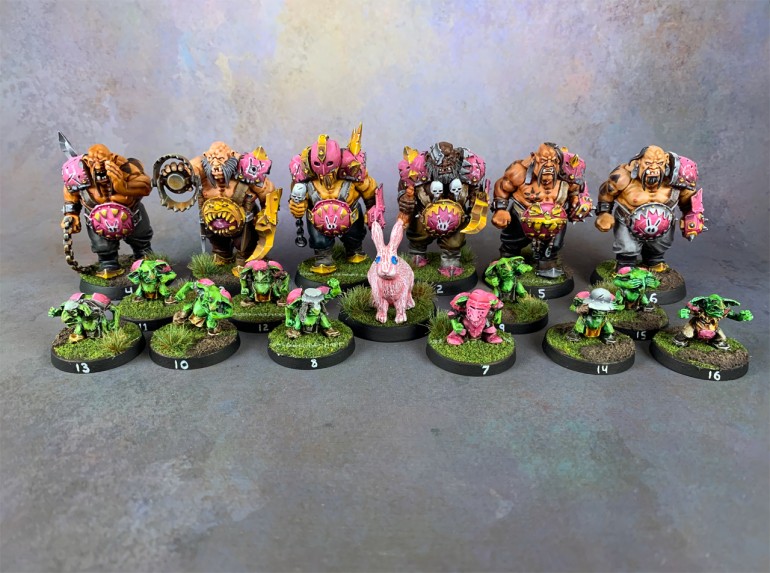
Progressing Your Roster and Team
After your first game (hopefully) you can start picking up more players for your team. What I like to do is to start filling in any gaps my roster may have. If there’s a positional you wanted, don’t have any of on your team, and couldn’t afford it starting out, then that’s what you want to snag.
Once the gaps are filled in, I like to flesh out areas that I could add more to. If I could only afford 1 Catcher to start with, and I’m not missing any other positions, then it’s time to buy that 2nd Catcher (assuming I wanted 2 Catchers of course).
It really helps with team management to know what your completed roster should look like. League play could change that look a bit as you find yourself struggling in certain situations, but a general idea of what you’re after will make choices easier.
Speaking of league play, I have an article about how to run a successful Blood Bowl league if you’re interested. I share how I run my league and what I’ve learned over the years of doing it.
Going back to Big Guys. I generally get them last, or when I feel comfortable enough with my team that it can succeed if the Big Guy makes a mess of a play. I do love Big Guys but man they can either make or break a play.
You’re also going to need to determine when to buy more re-rolls and/or that Apothecary. I usually buy my Apothecary after my first game if I can. Re-rolls I hold off on a bit until I’ve got a few more positions covered. Buying re-rolls after the season started costs twice as much, so you usually have to save a bit before you can afford them.
Managing Star Player Points (SPP)
This is something I covered in my tips for Blood Bowl, but it’s worth covering here since we’re specifically covering team management.
I recommend avoiding giving all the glory and SPP to a select few players on your team. Ideally you want a well balanced team in terms of leveling up and player TV. Having a few players with a ton of SPP, and in turn skills, makes losing those players a much more painful situation than if your team was diversified.
Having your best player smashed dead by a Minotaur could completely cost you the game if the rest of your team is rookies. Basically, don’t put all your eggs into one basket.
If you have 4 Catchers on your team, then try scoring with all of them, not just the 1 or 2 who are a higher level and have more skills. That way if you lose one of them you aren’t struggling to score later.
This is far easier with offense where you have more control over points with things like throwing and scoring TDs. On defense, where the most likely place to score SPP is in the form of casualties, it’s not as cut and dry.
Choosing an MVP
Running with that though is choosing your MVP, something you have some control over.
After each game you put up 3 players for MVP. On a new team, the choices tend to be obvious. Your positional players getting more SPP and leveling up is a huge boon for your team. Early on your can safely ignore Linemen and other grunts when choosing an MVP.
As the team progresses through a season though, the choices can become much harder. Do you put up that player who would level if he/she gets MVP, or a player who has 0 SPP so far?
These choices are situational and subjective, but I’ll share my opinion.
As a general rule I do not put forward Linemen and grunt type players for MVP. I may if those players have leveled a bit through other means, but even then there’s probably more value in giving those SPPs elsewhere.
I do try and spread the value of my team around. While it’s temping to put forward someone who will level with winning MVP, I look at whether it’s worth it.
Will that next level matter more than progressing a rookie closer to experienced?
There’s no easy choices here, and I can’t possibly cover every scenario. All I can say is try to level up as many players are you can and avoid having a few players who carry your team.
Avoiding Team Value (TV) Bloat
There is a min/maxing component here, but that’s not what I want to go into as it’s not something I typically do. However, there’s some basic things to consider with regards to your TV and bloat is an important factor in team management.
What is TV bloat?
Basically, TV bloat is when your team’s value (or player) is higher than it should be. By that I mean that the value of your team misrepresents the actual value.
For example, maybe you bought 10 Assistant Coaches or 8 Cheerleaders. Many coaches don’t feel you need either of those at all, some advocate for having 1 of each, but I can’t think of anybody who thinks you need 10 or 8 of either.
Each Assistant Coach or Cheerleader adds 10,000 to your TV. Using my extreme example, say you do have 10 Assistant Coaches. That’s adding 100,000 to your TV and Assistant Coaches only matter on one result on the kickoff table. You’re pretty well guaranteed to win that result, but at the cost of adding 100,000 to your TV it’s not worth it.
Team Value matters because it effects inducements. Let’s say I’m playing a game and normally I’d be around the same TV as my opponent. However, if I’ve got those 10 Assistant Coaches so now I’m giving my opponent 100,000 to spend in inducements.
My opponent could buy a team re-roll with that, which could end up being a deciding factor in the game. That re-roll is almost assuredly worth more than my odds of winning a 1 in 12 kickoff result with all those Assistant Coaches.
TV is also a factor if your league uses Spiraling Expenses where you subtract expenses from your treasury based on your TV. You’re paying an upkeep for the team. So, having an inflated TV based on having things you don’t need can be very harmful.
Roster Size
In Blood Bowl you can have up to 16 players on your team. Should you get 16 players on your roster? No, except for a few exceptions.
The only teams where having 16 players isn’t going to seriously bloat your TV would be Ogres (Runts have the Disposable skill), Goblins (cheap and lots of Secret Weapons), and Halflings (cheap players).
You want to have a few extra players in case of injuries, KOs, fouling, etc. My general rule is 2 extra players on my team. On some teams that’s 2 Linemen, and on others it’s extra positionals like Catchers.
Either way, 2 tends to be a the sweet spot for me. It’s enough to cover most situations but not too many that I’m wasting their cost and bloating my TV.
If you’ve got 5 players on your bench and you barely use most of them, then you’re just bloating your TV. Your going to give up inducements unnecessarily. It’s one thing if your TV is high because you have a well developed team. It’s another thing to give inducements because you’ve got players you don’t need. Doing that will put you at a disadvantage.
Now, league play may change how many you find you need for the bench. If you’re in a really bashy league and you’re losing 2-3 players a game, then a much fuller bench makes sense. If your league isn’t so bashy and has a lot of agile teams, then you might even be able to get away with 1 on the bench.
The point is to just be sure that every player on your team needs to be there.
Player Improvements (Leveling Up)
Congrats! You leveled up and rolled double 6s! You can increase strength by +1 or choose a skill from any category!
That situation is where TV bloat can really become problematic. Say the player that happened for is S5 already, so you could boost them to S6. You could do that and in turn add 50,000 to that players cost. Is going from S5 to S6 worth an extra cost of 50,000? Probably not – that’s just bloat.
However, taking a skill you couldn’t normally take adds 30,000 to the player’s cost. For reference, a normal skill increase adds 20,000, so just 10K more.
Being able to take Block on your Minotaur is absolutely worth the 10K extra in cost/TV over a normal skill. Making that Minotaur S6, however, is not worth the 50K increase.
This is true of any player improvement. You need to consider the gains vs the value added. Does that Treeman really need +1AV when it’s AV10 already? It’s only 10K more than taking a normal skill. The answer would almost always be no. There’s situations where you may, but I won’t break it all down here.
The point is to ensure that when you’re leveling up a player that you are making sure to not inflate their value needlessly. Again, TV is a factor for league play, and you want to be sure that you aren’t giving advantages to your opponents you could avoid.
When to Fire a Player
Another question of if a player’s value is worth it to the team, and also another topic that’s not always easy.
There is often some pretty straightforward choices. If you have a rookie Lineman and he/she suffers an injury like -1AV or -1ST then you’re almost always going to fire this player and hire a new one, if you have the cash anyway. That penalty makes their job harder and they’re not worth their value at that point. You might have to hang on to that player for a bit if you’re short on cash or saving up for a player you really need though.
The choice is harder if the player who gets injured is otherwise a great player. Let’s assume I have a Ghoul on my Undead team who has Dodge, Block, and Sure Hands and he’s my ball carrier. That Ghoul is injured with -1AV, now making the Ghoul AV6. Having AV6 is pretty terrible obviously.
In this case I would keep that Ghoul. Ideally the Ghoul isn’t getting hit as my ball carrier, but we know that’s a pipe dream. Still, that Ghoul has Block and Dodge which means it reliable stays on its feet when hit. Also, the Ghoul is still fast (MA7), so its still very capable of performing its job of getting the ball and scoring TDs.
I could choose to fire that Ghoul. That Ghoul would have a value of 110,000 (70K base + 40K in skills). I could fire that Ghoul and buy a new Ghoul. The new Ghoul would have a value of 70K, saving me 40K in value.
However, I now have a rookie Ghoul to run the ball in a league that’s already progressed; it’s a risky move. That’s why I would keep that Ghoul instead of firing him.
These are the type of choices you have to make with your team management and decide what’s right for your team. My general rule is when a player is no longer able to perform its job, or its job got substantially harder, that’s when it’s time to fire them.
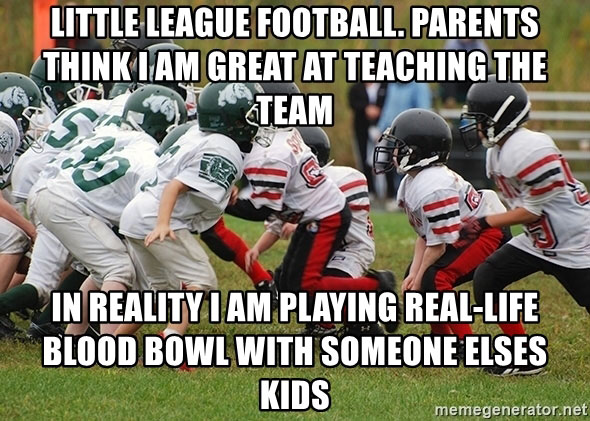
There are times when you can shift that players’ role too and keep them on. Skills like Guard are always useful. Maybe your player moves from the front lines to a supporting role if the skills are present.
When performing an intended role or a supporting role are no longer viable, just cut them.
Match Inducements
With the introduction of SPIKE! magazine for Blood Bowl there’s no shortage of inducements you can choose. There’s a lot of great team specific choices and a ton of star players at your disposal. I’m not going to cover them all, but I did want to talk about the value of the general ones to your team.
- 0-2 Bloodweiser Kegs (50K) – If you’re a fragile team then this is always a consideration. If you’re a bashy team and playing another bashy team, then there’s a lot of value in this inducement.
- 0-3 Bribes (100K unless you’re Goblins) – I’m not sure I’ve ever purchased this one, but I also don’t play teams that use Secret Weapons. Goblins buy bribes at 50K, and have a ton of Secret Weapons, so this is almost a given that you’ll take it. Other than that, unless you’re big into fouling, you can safely skip this one.
- 0-4 Extra Team Training (100K) – A re-roll for your team is pretty universally useful. This is my go-to for inducement choices unless my team is very well developed (late season) and I’ve got all the rerolls I truly need.
- Mercenaries (Unlimited & Various Prices) – Mercenaries are interesting. You’re buying a normal player at an increased cost with the option of getting a skill at a further cost increase. You’ll almost always be better off inducing a Star Player than going this route.
- 0-2 Star Players (Various Prices) – Star Players can give you a big advantage without a doubt. I’ll chat about this one a bit more below.
- 0-2 Wandering Apothecaries (100K) – Having a 2nd or 3rd Apothecary in crucial games has a lot of value. This is another go-to choice for me to make sure my best players remain on the field.
- 0-5 Special Play (100K) – I honestly don’t like these and we don’t use them in my league.
As I said, Blood Bowl now has a ton of inducements beyond the basics. There’s Wizards and Mages, Chefs and special Apothecaries, and even booze! Some teams even have their own special inducements, like Ogres with Riotous Rookies.
Regardless of the inducement, the question always remains the same – what’s the most useful to your team?
Overdog vs Underdog
The value management comes into play when the overdog spends cash to buy inducements. When you’re the underdog you always get petty cash equal to the difference in TV to spend on inducements. If the overdog has a TV of 1,200,000 and the underdog is at 1,000,000, then the underdog gets 200K in petty cash for inducements.
In this case buying inducements is a no-brainer. You’ve got free money, so spend it on whatever you need!
If you’re the overdog, then you need to decide if you’re spending cash to buy inducements. If you do, then the underdog gets what you spent, plus the TV difference, in petty cash.
Using the above example, the overdog spends 100K on inducements. Now the underdog is getting 300K in petty cash (100K from inducements + 200K in TV difference).
- Is your purchase needed?
- Will it outweigh the value you’re giving your opponent for inducement spending?
I can’t answer those questions for you, but that’s what you should be thinking about.
The same is true of the underdog. You’re getting free cash, however, if you spend money on top of that, then you’re giving the overdog a chance at more inducements too. Consider it wisely.
If the match is very important, like getting into playoffs, and you’ve got a healthy team with lots of gold in the treasury, then have at it. If it’s early in the season and you’re still building your team, then I’d think twice about spending gold on inducements. That gold will probably have more value staying in your treasury to buy more players or to replace dead ones.
Star Players
Taking Star Players can really help a team. The choice to use one comes down to a few things in my opinion.
- Is the Star Player a better asset than other inducement choices?
- Is the Star Player worth having in general? Some are a much better value than others.
- How important is this game? Is it to get into playoffs or give you a better seeding for playoffs?
I’m sure I could come up with more questions but you get the idea.
Your access to Star Players is going to depend on your team. Some teams have a wider range to choose from, where some teams only have a few.
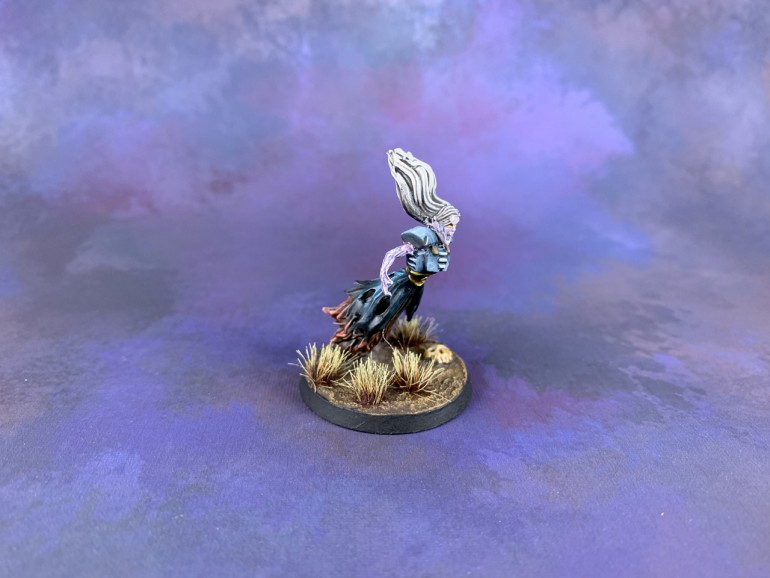
Some Star Players are as cheap as 50K where others are 430K. Will that 430K Star Player earn back their value in your game? That’s what you have to ask yourself.
There are too many Star Players to cover here. I just wanted to give you something to think about, not a definitive list of player or whether or not you need to take one.
Managing Your Treasury
In league play you may be subject to a rule called Expensive Mistakes, as well as Spiraling Expenses.
Expensive Mistakes is Blood Bowl’s way of managing teams with a lot of cash in their Treasury. It’s a potential penalty for hanging on to too much gold. Once you have 100K in your Treasury you start rolling on the table to see if you lose gold. The more gold you have, the more likely it is you lose some of it.
I’ve known some coaches who spend their Treasury constantly to avoid this rule. They might buy Assistant Coaches, Cheerleaders, more re-rolls, or even additional players, all to avoid losing gold.
I don’t agree with this approach. Buying things you don’t need is only jacking up your TV and creating bloat. You’re substituting one problem for another and TV bloat is the more problematic issue.
If you’ve got gold you’re not doing anything with, then that’s fine. What’s the big deal if you lose some gold here and there to Expensive Mistakes if you aren’t using it to begin with?
I would rather have gold in my treasury that I lose now and then, but is there to replace dead players or players I need to prune, than to inflate my TV and hurt myself in the long run.
Spiraling Expenses is Blood Bowl’s way of penalizing you for having a team with a high TV. You have to spend gold on upkeep to keep the team going. Once a team’s TV reaches 1,750,000 you start subtracting gold from your winnings after each match. The cost goes up the higher your TV.
Spiraling Expenses is why you need to avoid TV bloat. Every player on your team needs to be worth having. If you’re rostering subpar players they’re still adding to your TV. Reach that threshold for Spiraling Expenses and you’re now paying gold to hang on to players not worth their slot on the roster.
This is an area some coaches like to min/max on with team management to try and keep their TV down to avoid paying Spiraling Expenses.
Conclusion
That about covers my take on team management in Blood Bowl. All the above has been how I approach my teams and the way that works best for me. Your mileage may vary, but hopefully it’s proven insightful and useful to you.
The above is also advice and not anything written in stone. I have a Runt on my Ogre team right now who has -1AV. Yep, he’s not AV4! That Runt also has one skill: Diving Tackle.
Based on my advice above, that Runt should be fired. However, I’ve grown attached to the little bugger and he’s been surprisingly useful to me. I’m sure he won’t live much longer but damn it, I’ll let him live his best life until then!
Do what works for you and just have fun. Advice is just that; it’s something to consider. It’s not a set rule you need to follow. If you’re having fun, then that’s all that matters!
- Creative Twilight’s Future and My Thoughts (Feedback Welcomed!) - December 4, 2021
- My Top Gift Ideas for Miniature Painters & Hobbyists + Gifts to Avoid - December 2, 2021
- The Year That Was 2020 and Where I’ve Been - January 17, 2021

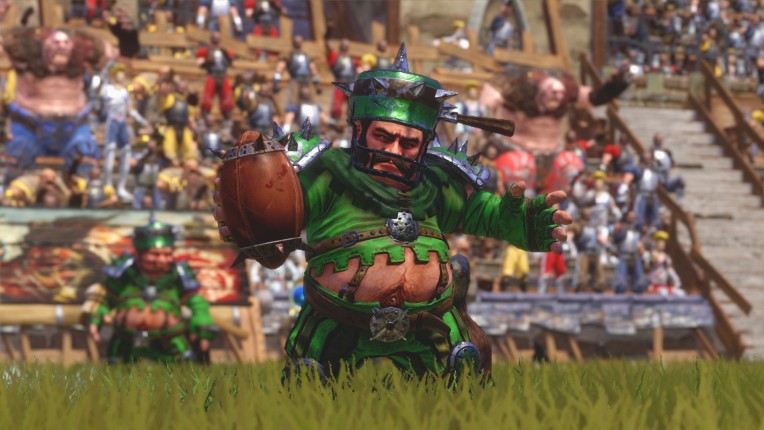

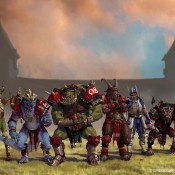

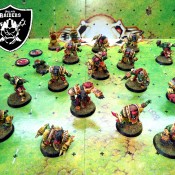
Hey just wanted to let you know, this was an excellent article.
Thank you! Unfortunately I haven’t played the current edition so it may be a bit outdated.
The MVP bit is wrong, selecting 3 is an alternative rule that some leagues run. The official rules it’s anyone in the roster that was in the match randomly selected .
But cracking little guide otherwise
Thank you.
I wrote this article about 4 years ago and I know things have changed a bit since then. I didn’t realize they went completely random on the MVP though – just like the video game.